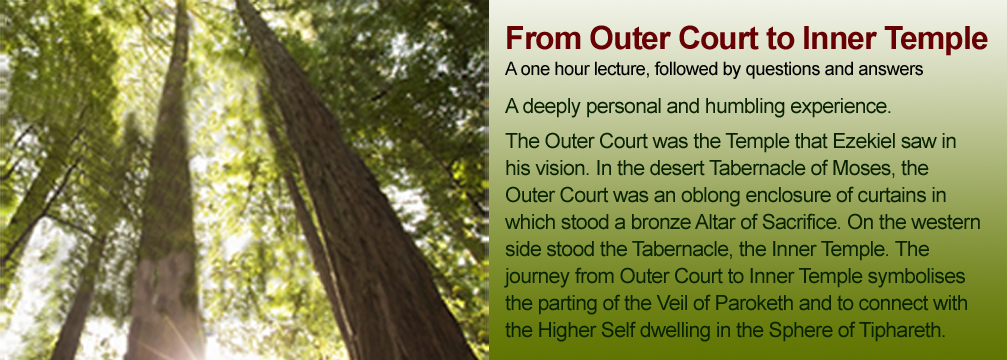International Order of Kabbalists - Advanced Courses and Specialised Lectures |
 |

|
|
From Outer Court to Inner Temple This lecture describes the Vision of Ezekiel and the Rending of the Veil of Paroketh, the Veil of the Temple. A Deeply Personal and Humbling Experience Ezekiel's vision of the temple: Ezekiel's vision of the temple described in detail in the biblical Book of Ezekiel, is a rich and complex narrative that has fascinated theologians, scholars, and mystics throughout history. From a Kabbalistic point of view, Ezekiel's vision is not merely a historical or architectural description but a profound spiritual journey with layers of symbolic meaning that resonate deeply within Jewish mystical tradition. Ezekiel, a prophet during the Babylonian exile, receives a vision of a divine chariot (Merkavah) and the Temple of Jerusalem. This vision is recounted in Ezekiel chapters 40 to 48, where Ezekiel is guided through the dimensions and details of a future temple by a heavenly figure. The journey progresses from the outer courts inward, revealing increasingly sacred spaces and detailed measurements of the temple complex. From a literal perspective, Ezekiel's vision is seen as a blueprint for a future temple to be rebuilt after the exile, but from a Kabbalistic viewpoint, it takes on deeper, mystical significance. Kabbalistic Interpretation of Ezekiel's Vision: Kabbalah, Jewish mysticism, interprets biblical texts through symbolic and metaphysical lenses, seeking to uncover hidden meanings that illuminate spiritual truths. Ezekiel's vision of the temple is understood in Kabbalah as a journey of ascent through the Sephiroth, the divine emanations through which God's energies are manifested. The Sephirotic Journey: In Kabbalistic thought, the temple represents not just a physical structure but a microcosm of the divine order. The progression from the outer courts to the inner sanctum parallels the soul's journey towards deeper union with the divine. Each gate, chamber, and courtyard in Ezekiel's vision corresponds to different stages of spiritual ascent, each guarded by angelic beings or divine principles. Symbolism of Measurement: The detailed measurements and proportions described by Ezekiel are not merely architectural specifications but symbolic representations of divine harmonies and balances. Kabbalists interpret these measurements as metaphysical truths about the ordered structure of the universe and the soul's alignment with divine will. In Kabbalistic interpretation, the detailed measurements and proportions described by Ezekiel in his vision are seen as symbolic representations of deeper metaphysical truths rather than literal architectural specifications. Here are some distinct examples of how Kabbalists interpret these measurements: The Chariot (Merkabah): Ezekiel describes a celestial chariot (Merkabah) that includes intricate details such as wheels within wheels, the appearance of crystal, and various faces (lion, ox, human, and eagle). Kabbalists interpret this chariot as a symbolic representation of the divine throne and the complex structure of the universe. Each component of the chariot corresponds to different aspects of creation and divine attributes (e.g., the faces representing different spiritual forces). Proportions and Measurements: Ezekiel provides specific measurements and proportions for various elements in his vision, such as the size of the wheels, the height of the creatures, and the dimensions of the temple. Kabbalists interpret these measurements as symbolic representations of divine harmonies and balances in the universe. For example, the numerical values and proportions may correspond to Kabbalistic principles such as the sephiroth (divine emanations) or other metaphysical concepts. Symbolism of Numbers: Kabbalistic interpretation places great significance on numbers as symbols of divine attributes and principles. The numbers and measurements described by Ezekiel are often interpreted in terms of these symbolic meanings. For instance, the number four (represented by the four faces of the cherubim) can symbolize completeness or the four directions of the universe. Metaphysical Truths: Beyond their literal descriptions, Kabbalists view Ezekiel's measurements as conveying metaphysical truths about the ordered structure of the universe and the alignment of the soul with divine will. For example, the symmetry and precision in the measurements may symbolize the harmony and balance that exist in the spiritual realms, encouraging the soul to strive for alignment with these divine principles. Spiritual Journey: Ezekiel's vision is often interpreted as a spiritual journey through different levels of reality and consciousness. The measurements and proportions guide the soul through these levels, symbolizing the stages of spiritual ascent and the attainment of higher states of consciousness. Overall, Kabbalistic interpretation of Ezekiel's vision emphasizes the symbolic and allegorical nature of the measurements and proportions described. These symbols are believed to convey profound metaphysical truths about the structure of the universe, the divine attributes, and the soul's journey towards spiritual perfection and alignment with divine will. The Rending of the Veil: The concept of the rending of the veil, often associated with the innermost sanctuary of the temple, signifies the transcendence of physical boundaries to access higher spiritual realms. Kabbalists see this as the opening of the gates to mystical experience and divine revelation, where the veil between the mundane and the sacred is lifted. Quotes from Kabbalistic Texts: Kabbalistic literature, such as the Zohar and writings of the Ari (Rabbi Isaac Luria), provides insights into the mystical interpretations of Ezekiel's vision: Zohar - The Book of Splendour: "And I looked and behold, the glory of the Lord filled the house of the Lord" (Ezekiel 43:5). The Zohar interprets this as the manifestation of divine light filling the innermost chambers of the soul, symbolized by the inner sanctum of the temple. Ari's Interpretation: Rabbi Isaac Luria, known as the Ari, delves into the intricate symbolism of the temple's dimensions and the significance of Ezekiel's journey. He explains how each element corresponds to spiritual attributes and the Sephiroth, illustrating the interconnectedness of the physical and spiritual worlds. In the context of Jewish mysticism and Kabbalah, the vision of Ezekiel is often interpreted through the lens of the sephiroth, which are the ten attributes or emanations through which God reveals Himself. Each sephirah represents a different aspect of the divine and a different quality through which God interacts with and manifests in the world. Ari, or Rabbi Isaac Luria, was a 16th-century Kabbalist who provided a detailed interpretation of Ezekiel's vision in terms of the sephiroth. Here's a brief overview of how Ezekiel's vision is attributed to the sephiroth according to Lurianic Kabbalah: Kether - Crown: This represents the highest aspect of God, symbolizing divine will and the source of all other sephiroth. In Ezekiel's vision, Kether is often associated with the image of God's throne or chariot (Merkabah). Chokmah - Wisdom: This sephirah represents the first flash of insight or inspiration. In Ezekiel's vision, it corresponds to the "wheel within a wheel," symbolizing the mysterious and profound nature of God's wisdom. Binah - Understanding: Binah is the sephirah of understanding and discernment. It is associated with the various forms and faces described in Ezekiel's vision, representing the multifaceted nature of divine understanding. Chesed - Kindness: Chesed represents loving-kindness and compassion. In Ezekiel's vision, it corresponds to the face of the ox, symbolizing strength and stability. Gevurah - Severity or Judgment: Gevurah represents strength, discipline, and judgment. It is associated with the face of the lion in Ezekiel's vision, symbolizing the strength and severity of divine judgment. Tiphareth - Beauty or Harmony: Tiphareth is the sephirah of beauty and balance, representing harmony and compassion. In Ezekiel's vision, it is associated with the face of the human, symbolizing the balanced and compassionate aspects of divine revelation. Netzach - Eternity or Victory: Netzach represents eternity, triumph, and perseverance. In the vision, it corresponds to the wings and spirit of the creatures, symbolizing the eternal and victorious nature of God's presence. Hod - Glory or Splendour: Hod represents glory, majesty, and humility. In Ezekiel's vision, it corresponds to the wheels, symbolizing the splendour and majesty of God's presence as it moves throughout creation. Yesod - Foundation: Yesod is the sephirah of foundation and connection, representing the divine channel through which blessings are transmitted to the world. It corresponds to the firmament or expanse in Ezekiel's vision, symbolizing the foundational aspect of divine revelation. Malkuth - Kingdom: Malkuth is the sephirah of kingdom and sovereignty, representing the divine presence manifest in the physical world. In Ezekiel's vision, it is associated with the throne of God, symbolizing the ultimate kingship and rulership of God over all creation. These attributions illustrate how Lurianic Kabbalah interprets the visionary and symbolic language of Ezekiel's mystical experience as a reflection of the divine attributes and the dynamic interaction between God and creation through the sephiroth. The Veil of the Temple: The rending of the veil is a pivotal moment in both biblical and Kabbalistic symbolism. Taking the Biblical Context (Matthew 27:51): "And behold, the veil of the temple was torn in two, from top to bottom." This event is traditionally understood as signifying the opening of access to God's presence directly, beyond ritualistic barriers. Kabbalistic Interpretation: Kabbalists view the rending of the veil as a metaphor for the soul's purification and elevation, where barriers between the mundane and divine are dissolved through spiritual ascent and divine grace. Conclusion: Ezekiel's vision of the temple, when viewed through the lens of Kabbalah, becomes a mystical journey of the soul towards divine union. It transcends historical narrative to reveal profound truths about the structure of creation, the nature of spiritual ascent, and the ultimate unity of all existence with the divine source. Kabbalistic interpretations enrich our understanding of Ezekiel's vision by unveiling layers of symbolic meaning and spiritual significance that resonate across theological and mystical traditions. The rending of the veil symbolizes not only a historical event but a timeless invitation to seek and experience the presence of the divine in every aspect of existence. ==================================================================== |







